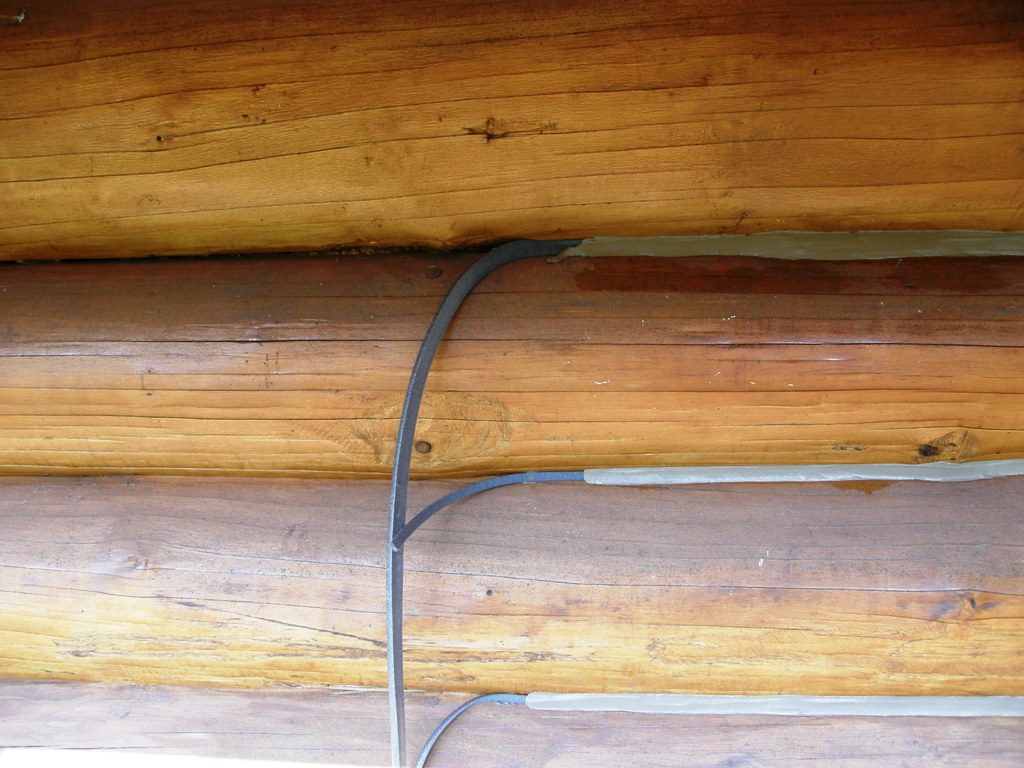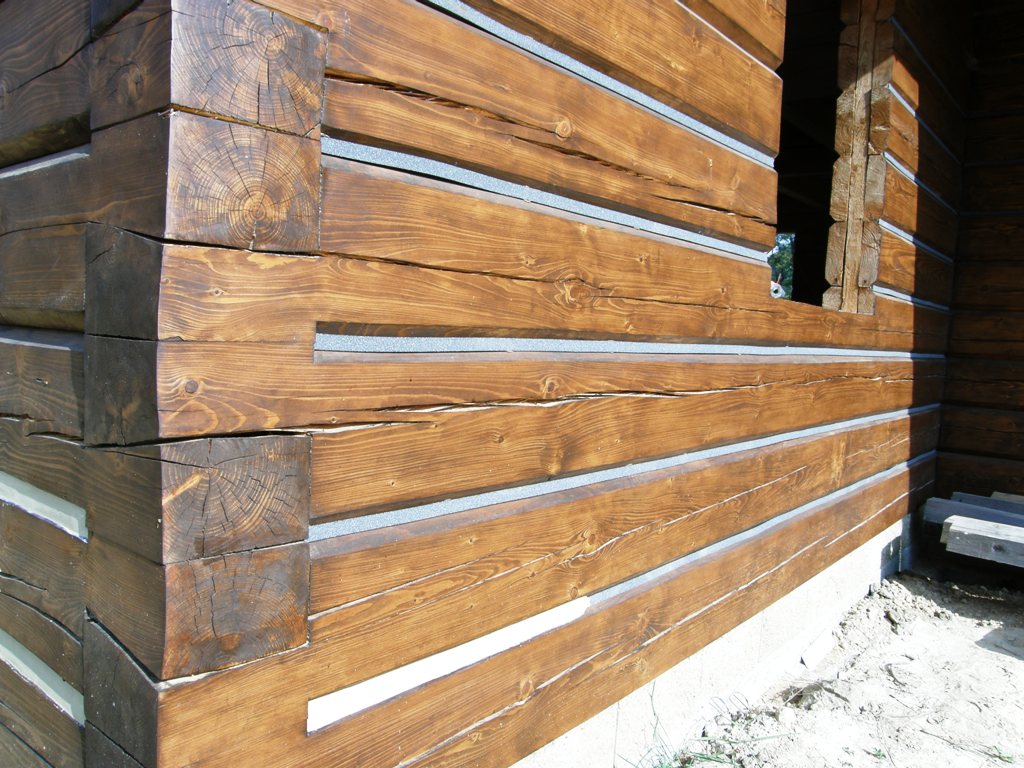Choose from a list of topics that interests you. If you have questions that interest you and are not listed here, please contact us. We will answer and complete the answers to the list.
FAQs
1Is it good to chink immediately after construction ?
It is appropriate to chink as soon as the construction of the cabin or log home is done? Wooden buildings are mostly built of raw material and there is a presumption that it will be several more years to work and sit down. This is the main reason why it is always better to wait with sealing. We recommend at least 2 years (depending on environment) before proceeding to cementing. Sealants are flexible, dilates the movement of wood to incredible 25%, but already we know from our experience, that the movement from the complete establishment of the new buildings is often much more pronounced. Some logs for log cabins in a row event, while turning corners (right handed and left-handed wood). This causes the cracks appear in sealed gaps. For flat logs cabins is it similar, depending on the technology works. Some manufacturers of flat log cabins leave the gap between the beams, the beams will allow freedom of movement and can be drying to rotate. If you have no choice and can not wait, so the cabin or timber before the cement with the fact that after several years of adjustment shall be made and broken connections with additional reparements .Whether you build with dry wood, so you can putty immediately after construction. All of these joints immediately after the construction of houses sit well and so it seemed after a few years. Wood is a natural material and always will work. It depends of course on the technologies and methods of establishment of the logs. Different manufacturers will differ from each other and the quality of the resulting effect, but the vast majority will be at least partially similar problems occur.








2Why is it necessary seal gaps or cracks in the beams?
Why is it necessary seal gaps or cracks in the beams? There are many reasons why the use of wooden joint sealants. The most common include significant improvements in thermal properties of buildings, protection of timber and logs from moisture, insects and various wood-destroying parasites.Sealing approach significantly extends the life of the house, save a lot of energy and avoid later problems with the contested timber. There are some wooden structures, which need not necessarily to be sealed. Such are flat log houses, where the gaps are covered by a wooden bar. Also in such constructions you can find places with cracked beams and corners, where it is necessary to prevent weathering.
3It is necessary to use backing rod?
It is necessary to use backing rod? Backing rod is guaranteed sufficient dilatation joints and proper function of sealant. It is important, that the sealant is assigned only in 2 points.The middle space in joint which remained free is for the possibility of movement and expansion. This will allow flexible PE sealing cord, to which the sealant will not stick and can thus move freely around. Another advantage of using backing rod is also a saving of material, which is compared with the cost of sealant more expensive. This does not mean that we can only replace the sealant with backing rod. It should be observed as a thick sealant deposited on a cord. Always depends on the overall width and depth of the joint. Among the common mistakes are applied very thin layer of material on the cord, which after drying causes the so-called contour lines circumscribe and later cracking grout above backing rod. Whether you can not put backer rod, there shall be used only sealant foe example around windows, doors, into small cracks, etc. ..






4It is preferable to chink the cabin before any painting or after treatment ?
It is preferable to chink the cabin before any painting or after treatment? It is always best to apply the sealant to the clean, unpainted wood. But in practice it is usually not possible, because most of the houses are already painted with something. Hence some advice and information to help you determine whether the surface is suitable or not. - If the wood is treated against wood pests such devices (bochemit, lignofix, pine salt and others), the surface remains adherent and can be sealed.These compositions are usually water based. - Whether the surface is painted with oil or natural. TLC staining, which is characterized by deep soak into the wood, we can generally say that, these substance are acceptable. If you are going to just paint, so it is better chink before painting. If already painted, it is better to wait at least several months after coating. This means they have time to soak into the wood. Rest is completed with the weather and sun. Surface of wood becomes again abrasive (sun, rain). - If you are unsure, it is always a good idea to test on some gaps, and after about 3 weeks to try to pick off the material from wood. This way you can see how well the surface of the wood is adhesive for sealant. Whether is easy to separate from the wood, the joints has to be cleaned up to the wood. - Do not apply to other old sealants , which does not hold in the surface. It should be cleaned before sealing.
5What is the best width of joints?
The required gap width depends on the diameter of the logs used in the log cabin (or the width of the timber beams for timber-framed structures). Another factor in decision-making is the age of the construction, the stage of drying, and the settling of the building. In general, it can be said that the smaller the diameters used, the smaller the gaps needed. For log cabins with average logs approximately 25–30 cm wide, we recommend a gap width of at least 25 mm. This is related to the depth of the gap. The optimal depth of the gap for sealing is approximately one-third of its width. A wider gap won't hurt and, on the contrary, may improve the possibility of dilation.
In the case of timber-framed structures, design also plays a crucial role, and wider gaps are desirable. For example, for a gap width A = 30 mm, a depth B = 10 mm is recommended (see the diagram).
For log cabins with average logs approximately 25–30 cm wide, we recommend a gap width of at least 25 mm. This is related to the depth of the gap. The optimal depth of the gap for sealing is approximately one-third of its width. A wider gap won't hurt and, on the contrary, may improve the possibility of dilation
Gallery
6What are the most common mistakes when are you chinking?
Before you start sealing, it's important to realize that buildings are typically constructed from raw wood, and the entire structure will settle over several years. As mentioned in the first question, sealing should ideally occur 2 or more years after construction. While the sealant is flexible and can withstand up to about 63% elongation before breaking, in some cases, there can be more significant movements. This is mainly due to the drying of the wooden fillets in false corner notches and the drying of rounds in the cladding of false log walls. These fillets are initially attached while still wet to a firm and immobile substrate. In the case of a 20 cm width, they can dry up to 2 cm. In such situations, cohesive failure of the sealant may occur (see the diagram). If this happens, it's advisable to wait at least 1 year for the fillets to dry (or until the gap no longer enlarges), and then reseal it with a new layer. When constructing a new log cabin, we recommend filling these gaps with a flexible sealing cord and sealing them after the first heating season. Another mistake is using a thin layer of sealant.
7How much material do I need?
The material consumption is always dependent on various factors. To calculate, you need to know the width, depth, and shape of the gap. In corners, consumption is again very specific and depends on the shape and fitting method of the logs. Therefore, we provide average values obtained from practical tests. For precise calculation, it's always better to perform a test on a specific log cabin or timber frame.
Gap width 25 mm, average yield from 600 ml of sealant: 5.5 meters
Gap width 30 mm, average yield from 600 ml of sealant: 2.2 meters
Gap width 40 mm, average yield from 600 ml of sealant: 1.2 meters
For gap widths of 50 mm and above, it's advisable to test on a case-by-case basis.
We recommend always conducting a test on a specific timber construction. For round log cabins, we typically calculate a yield of 5.5 meters of gap from one 600ml package. For square logs, the yield varies according to the gap width, as indicated in the table above.
8What color of sealant can I choose?
For now, the selection of the six basic colors: white nos. 110, spruce-pine no. 120, No.130 light brown, yellow-brown no. 140, dark-brown no. 150, natural gray no. 160. All sealants can be purchased in packs 600 ml sausage, or 310 ml cartridges. For more exact understanding of colors it is possible to order a free color sampler. On request we will send you a free sampler. Sealants can be painted over after drying and if necessary to fine-tune the color to your needs. It is necessary to consider in advance whether we want to highlight gaps or rather hide. For some kind of homes we prefere to contrast a white gap to dark timber. We will recommend to the interior rather lighter (timber interiors are dark and bright gap rather bring more light into the interior). Note: just only our opinion. názor.
9What weather can I apply sealants?
Before sealing, it is advisable to check the weather forecast for at least the next few days. The temperature should be at least +5 °C for applying sealants.
Various factors affect the drying and work with sealants, but the most significant are: ambient temperature, air humidity, wind, and the absorbency of the surface.
The applied sealant should be protected from direct rain for several hours. It must not be exposed to temperatures below 0 °C for at least 7 days after application. The final plastic properties of the sealant throughout its mass are achieved after 1 month. The sealant should be protected from strong sunlight for several hours after application. This could cause rapid evaporation of water in the thinner layers of the applied sealant, leading to small cracks or bubbles. This is especially common in the autumn when there are significant weather changes. Early low temperatures in the morning and high temperatures in the afternoon, with the sun shining directly into the wall. In the event that cracks do form (the risk is mainly with gaps wider than 30 mm), they should be punctured the next day and repaired while the sealant has not fully dried.







